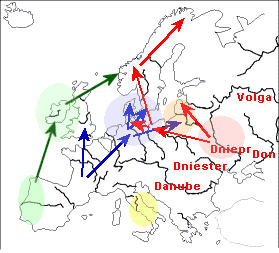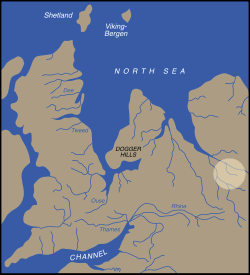![]()
Addendum: The Doggerland Revelations
In the four years since I originally posted these speculations, two
interesting pieces of information have come to my attention.
Earlier in this essay, I suggested
that the original speakers of proto-Germanic could be identified with
the Magdalenian reindeer hunters who spread northward from southern
France into England, Germany, and Denmark -- as indicated by the blue
arrows on the map below -- during the waning years of the last
Ice Age.
I accepted, however, the conventional wisdom that the hypothetical Germanic language of the eastern part of England had been wiped out by a subsequent expension of Celtic speakers and that modern English is the descendent of continental Germanic languages from northern Germany or Denmark -- the area indicated by the pale blue circle on the map -- whose speakers are known to have invaded England in the fifth centuiry AD.
 It appears now that this is not necessarily so.
It appears now that this is not necessarily so.
In March 2007, the New York Times ran an article discussing the DNA evidence for the theory that the English and the Irish are both largely descended from late Ice Age migrants, with only a small genetic contribution from more recent invaders. This article extensively cited the conclusions of Stephen Oppenheimer, but it also included these eye-catching paragraphs:
Dr. Oppenheimer has relied on work by Peter Forster, a geneticist at Anglia Ruskin University, to argue that Celtic is a much more ancient language than supposed, and that Celtic speakers could have brought knowledge of agriculture to Ireland, where it first appeared. He also adopts Dr. Forster’s argument, based on a statistical analysis of vocabulary, that English is an ancient, fourth branch of the Germanic language tree, and was spoken in England before the Roman invasion. . . .Foster's ideas have understandably not been well-received by linguists. He is, after all, a mere geneticist -- and one whose conclusions fly in the face of all conventional theory. However, if only because they align so closely with my prior speculations, I have to take them seriously.
Germanic is usually assumed to have split into three branches: West Germanic, which includes German and Dutch; East Germanic, the language of the Goths and Vandals; and North Germanic, consisting of the Scandinavian languages. Dr. Forster’s analysis shows English is not an off-shoot of West Germanic, as usually assumed, but is a branch independent of the other three, which also implies a greater antiquity. . . .
Historians have usually assumed that Celtic was spoken throughout Britain when the Romans arrived. But Dr. Oppenheimer argues that the absence of Celtic place names in England — words for places are particularly durable — makes this unlikely.
If Foster is correct, then the blue arrows on the map above correspond precisely with his four branches of Germanic -- English with the left-hand arrow, West Germanic with the lower right-hand arrow, which points to the Netherlands and northern Germany, East Germanic with the arrow that zooms off to the right, and North Germanic with the two small arrows that head up into Denmark and Sweden.
That would be interesting enough in itself, but there's also a second piece to the story..
In April 2007, an article appeared describing how archaeologists were mapping a "lost country" beneath what is now the North Sea, between Britain and the Netherlands. Hunter-gatherer communities had thrived there between about 10,000 and 6000 BC, when it was drowned by rising sea levels as the last of the Ice Age glaciers melted.
 In
the map, present-day Britain is shown on the left, with part of
Ireland beyond it. The present-day Netherlands are on the
right, and Doggerland is in between and connected to both.
In
the map, present-day Britain is shown on the left, with part of
Ireland beyond it. The present-day Netherlands are on the
right, and Doggerland is in between and connected to both.A later article from July 2008 (which now appears to be available only as paid content) provided additional details, including the provocative notion that "Mesolithic people have in the past been depicted by researchers as restless nomads and Doggerland as a land bridge through which they passed without leaving a trace. The new map suggests that, on the contrary, Doggerland would have been an ideal environment for them to linger in."
In fact, the article suggests that Doggerland may have been such a rich environment that its inhabitants were not nomads at all, but had the luxury of a sedentary lifestyle -- something that has been available to hunter-gatherers in only a few optimal locations, such as prehistoric Japan and the Pacific Northwest.
It seems as though we might conceive of Doggerland almost as a kind of local, small-scale Atlantis, whose gradual submergence forced its inhabitants to migrate to Britain on the west and the Netherlands on the east. As they did so, they could have maintained their sedentary ways by acquiring the new techniques of agriculture, which were just then arriving from the east and south.
Additional evidence is provided by the Frisian language and culture. These days, the Frisians amount to some 400,000 people living in one province of the Netherlands and speaking their own distinctive language. In the Dark Ages and Middle Ages, however, they extended much further up and down the North Sea coast. (The pale circle on the map indicates roughly the present location of Friesland.)
Frisian has the distinction of being the closest of any language to English. There is even a bit of traditional doggerel which was concocted to demonstrate the point. It runs, "'Good butter and good cheese' is good English and good Fries." (Some excellent translations of Bob Dylan songs into Frisian help make the case as well.)
The unique closeness of this relationship has always provided something of a problem for the theory that English is descended from the languages of German and Danish invaders who came from much further east than Friesland.. However, if we accept that both English and Frisian have been spoken in their current locations for the last 10,000 years -- and that the proto-English which gave rise to both of them was also the language of lost Doggerland -- the paradoxes vanish.
The only unanswered questions that remain have to do with what the the potentially sophisticated Mesolithic culture of Doggerland might actually have been like -- and what traces it may have left in the societies on either side of the North Sea that it influenced.
January 2009
(Slightly revised April 2009. Better map added October 2009.)
Return to Worlds of Wonder
Return to Trogholm
Background courtesy of
Eos
Development